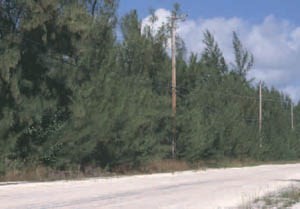 There are around 18,000 plants native to North America. These plants provide food, fiber, and habitats that people and wildlife depend on. Unfortunately, many invasive (non-native species) plants have become a threat to the native plants and are the second greatest threat (next to humans) to them. Many of these invasive plants have found their way into the Everglades. The Park staff work throughout the year to remove these plants whenever they can in order to protect the natural habitat. One of these invasive species is the Australian Pine (Casuarina equisetifolia).They have invaded thousands of acres in southern Florida.
There are around 18,000 plants native to North America. These plants provide food, fiber, and habitats that people and wildlife depend on. Unfortunately, many invasive (non-native species) plants have become a threat to the native plants and are the second greatest threat (next to humans) to them. Many of these invasive plants have found their way into the Everglades. The Park staff work throughout the year to remove these plants whenever they can in order to protect the natural habitat. One of these invasive species is the Australian Pine (Casuarina equisetifolia).They have invaded thousands of acres in southern Florida.
The Australian Pine, as you may have guessed, is native to Australia, but also to Malaysia and southern parts of Asia. This plant came to Florida in the late 1800s and was used for ditch and canal stabilization, along with for its shade and lumber.
This tree is tall and can grow up to 100 feet or more. Its needles have a soft appearance and it produced small, oval cones. This tree grows fast and can provide thick shade to an area. Its leaves and fruit completely cover the ground under it. The checmicals from the leaves and keep other plants from growing in that area. Because its roots can produce nitrogen, it can grow well even in soil that is poor. However once it is growing, it can change the light, temperature, and soil of the beach habitats because it displaces native species and destroys the natural habitat for wildlife and insects. Because of these shallow roots, they tend to topple over during storms and high winds, which can cause hazards. Since it does not have thick of shallow roots, it helps contribute to beach and dune erosion, which negatively affects the ways sea turtles and alligators nest. By displacing deep-rooted native plants, beaches are more prone to erosion. They also provide little to no habitat for the wildlife in the area.
As of right now, manual removal of seedlings and saplings is recommended. If there is a heavier infestation of the Australian pine, a systemic type of herbicide is applied to bark, stumps, or foliage. Planned fires also are used when able. They are resistant to salt spray.
Visit the Everglades
If you’d like to help with the removal of invasive species, contact the Everglades National Park service and see what you can do to help. Many times, if you spot a plant in the Everglades that you think is invasive, you can notify a park ranger and they will look into it. While you’re visiting the Everglades, explore the area even more on an airboat tour. Call Captain Mitch’s Airboat Tours at 800-368-0065 or click here to book a tour today.






